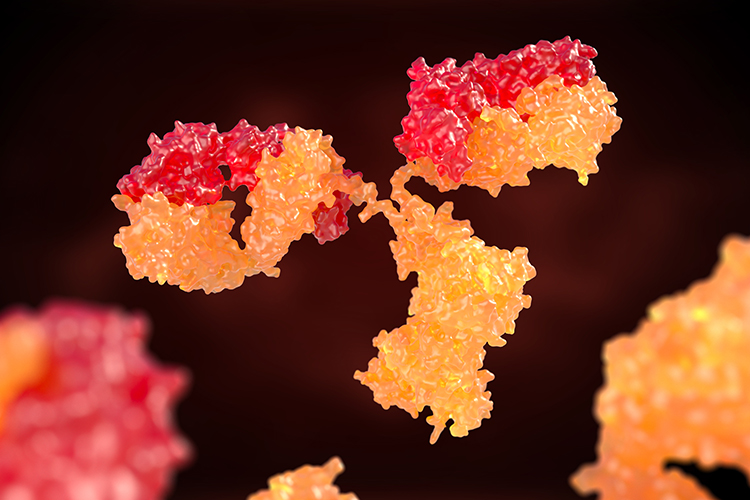VIRTUAL ROUNDTABLE HIGHLIGHTS: Emerging tools for the analysis of biologics and biosimilars
Posted: 28 June 2021 | European Pharmaceutical Review | No comments yet
In this virtual roundtable, Scott Bradley (Principal Research Scientist, Eli Lilly and Company), Joan Malmstrøm (Principal Scientist, Novo Nordisk) and Kelly Sackett (Principal Scientist, Pfizer) exemplified how high-resolution nuclear magnetic resonance (NMR) is a key technology that provides critical information about protein structure and dynamics. Here, the participants offer some useful takeaways from the event.


Current role of magnetic resonance in biologics characterisation
Nuclear magnetic resonance (NMR) requires very little sample preparation, thus saving cost. It sees whatever has protons: protein, excipients, buffers, impurities (eg, silicone oil),1 etc, and immediately delivers a snapshot of the whole picture. Furthermore, molecular interactions and molecular motion are detected by NMR. While traditional techniques give the average, the bulk; NMR provides atomic resolution of molecules that are in equilibrium. It is very information rich. Other advantages are that if, for example, we have the full assignment, we can then dig into the dataset and know where the high order structure (HOS) changes happened. NMR gives us information in real time and under relevant conditions. It can also be used as a reaction monitoring tool.
We consider NMR to be a key part of the biologic’s characterisation toolbox. The following examples highlight some of the additional information that NMR affords:
- NMR can detect HOS changes that are not due to primary structure variations and therefore not easily observed by other techniques such mass spectroscopy (MS). For example, we have detected by NMR aggregation changes in several studies where molecules have the propensity to aggregate to form hexametric units or fall apart to monomeric form. Changes could be seen in the two-dimensional (2D) NMR but also in the one-dimensional (1D). Consequently, we could determine how the excipients were affecting the aggregation.
- We have also been able to detect, by NMR, changes in the HOS of mid-size protein, when changes from L to D form in the protein backbone occurred. These changes are not detectable with liquid chromatography-mass spectrometry (LC-MS), yet they are visible in the 2D HOS spectra.
- In a recent publication, the use of 1D and 2D HOS of monoclonal antibodies (mAbs) was compared with other spectroscopic techniques.2
What are some current applications of NMR in the biologics field?
NMR can be used for a wide variety of biotherapeutic applications,3,4 such as conformation assessment (HOS),5,6,7,8 quantification of reference standards, 9 study of excipient-protein interactions in formulated material, impurity profiling10 and bioproduction analytics.11 Another important application of NMR is the characterisation and batch release of polysaccharide vaccines.12
Electron paramagnetic resonance (EPR) is complimentary to NMR, detecting anything with an unpaired electron such as radicals and transitions metals. We have used EPR in cases where we suspected trace metals had leached from stainless steel containers, which might have caused degradation.
Solid-state NMR (ssNMR) is a recent development, which is useful for large biomolecular systems and can be used as an R&D tool for more than just QC.13
Importance of a non-destructive method
NMR is non-destructive which means that with one sample many experiments can be performed, and in physiological conditions. TD-NMR relaxometry is non-destructive and also truly non-invasive since it is able to measure formulated drugs in their original container: syringes and/or vials.
How does NMR fit into the multi-attribute method (MAM) concept?
Given that NMR is an information rich technique, it has the ability to gather multiple critical attributes from a single experiment or from multiple experiments run with the same sample. For example, NMR is used for the analysis and batch release of glycoconjugate vaccines. From the NMR analysis, we can obtain polysaccharide identification, quantification and functional groups information. We can not only gain insight into the drug substance but also the drug product. Multivalent drug product can also be analysed and the polysaccharide antigens identified.12
NMR is also used for impurity profiling of biotherapeutics. Here, the impurities are not only identified but also quantified from the same 1D spectrum.10 Similarly, with bioproduction analytics11 we get both identity and quantification of process metabolites in one go.
When Time-domain NMR (TD-NMR) relaxometry is used, it is even possible to directly obtain multiple critical attributes from the drug product in a syringe or a vial such as fill check, aggregation or bound water if the drug product is a lyophilised cake.14
Can an NMR fingerprint be used to confirm a drug product formulation?
Yes, NMR data can used as fingerprint spectrum/a for a formulated drug. When analysing the different batches and comparing with the reference fingerprint, if everything is the same as in the reference, then we can confirm concentration, identity and folding and therefore confirm the quality of the drug product formulation.
What role do the regulatory agencies play in adoption of new technologies?
Partnerships between pharma, regulatory and government agencies have been working to bring the resolving power of NMR to really understand the properties of large biotherapeutics and ensure they are controlled and understood. These collaborations will be key for the future and NMR is a really strong component in the toolbox to better understand such therapeutics, for example, John Marino’s group.5,15 The work is not done by pharma anymore but with academic collaboration to develop the technique further and bring the benefits.
The high level of engagement of the National Institutes and US Food and Drug Administration (FDA)16,17 regulatory agencies has not been seen in any other area within the NMR development space, here the regulator have taken an active and leading role. This is key because it has facilitated multi-national collaboration and the ability to reference the work of regulatory agencies lends credibility to our work when we try and deploy new methods internally.
The continuation of this level of collaboration between the pharmaceutical industry, academia and government instructions will result in the increasing acceptability of NMR and encourage its use.
Trends you see coming in biologics characterisation
In high resolution NMR, any development in hardware and/or pulse programmes18 that increase sensitivity will be very welcome. We envisage more QC methods that involve quantification not only of the small molecules (impurities, excipients) but also quantification of biotherapeutic active pharmaceutical ingredients (APIs).
Automation and standardisation will be a must.
Time domain NMR (TD-NMR), also called “benchtop relaxometry”, is going to be a very useful tool because when we start considering cost and where an NMR can be located, we realised that benchtop devices are more prolific for the pharmaceutical companies, being deployable not only to the development laboratory but also to the manufacturing floor. We use a very highly specific technique, high resolution NMR, to train the less specific techniques like TD-NMR, using chemometric type tools or other methods.
Low field Fourier Transform NMR (FT-NMR) is also of high interest because of the easy deployment to manufacturing. Its uses include evaluating excipient concentration in drug product formulations, replacing several HPLC methods. This will make an impact in the QC area.
Watch the ‘Emerging tools for the analysis of biologics and biosimilars‘ virtual roundtable event on watch on-demand here!
References
- Malmstrøm J. Quantification of Silicone Oil and Its Degradation Products in Aqueous Pharmaceutical Formulations by 1H-NMR Spectroscopy. Journal of Pharmaceutical Sciences [Internet]. 2019 [cited 11 June 2021];108(4):1512-1520. Available from: https://jpharmsci.org/article/S0022-3549(18)30737-8/fulltext
- Hwang T, Batabyal D, Knutson N, Wikström M. Use of the 2D 1H-13C HSQC NMR Methyl Region to Evaluate the Higher Order Structural Integrity of Biopharmaceuticals. Molecules [Internet]. 2021 [cited 11 June 2021];26(9):2714. Available from: https://www.mdpi.com/1420-3049/26/9/2714/htm
- Golovanov A, Bramham J. How can NMR spectroscopy help protein biopharmaceutical development? [Internet]. European Pharmaceutical Review. 2020 [cited 11 June 2021]. Available from: https://www.europeanpharmaceuticalreview.com/article/113214/…
- Kiss R, Fizil Á, Szántay C. What NMR can do in the biopharmaceutical industry. Journal of Pharmaceutical and Biomedical Analysis [Internet]. 2018 [cited 11 June 2021];147:367-377. Available from: https://doi.org/10.1016/j.jpba.2017.07.004
- Brinson R, Marino J, Delaglio F, et al. Enabling adoption of 2D-NMR for the higher order structure assessment of monoclonal antibody therapeutics. mAbs [Internet]. 2018 [cited 11 June 2021];11(1):94-105. Available from: https://www.ncbi.nlm.nih.gov/pmc/articles/PMC6343768/
- Arbogast L, Brinson R, Formolo T, et al. 2D 1HN, 15N Correlated NMR Methods at Natural Abundance for Obtaining Structural Maps and Statistical Comparability of Monoclonal Antibodies. Pharmaceutical Research [Internet]. 2015 [cited 11 June 2021];33(2):462-475. Available from: https://doi.org/10.1007/s11095-015-1802-3
- Hwang T, Batabyal D, Knutson N, Wikström M. Use of the 2D 1H-13C HSQC NMR Methyl Region to Evaluate the Higher Order Structural Integrity of Biopharmaceuticals. Molecules [Internet]. 2021 [cited 11 June 2021];26(9):2714. Available from: https://www.mdpi.com/1420-3049/26/9/2714/htm
- Haxholm G, Petersen B, Malmstrøm J. Higher-Order Structure Characterization of Pharmaceutical Proteins by 2D Nuclear Magnetic Resonance Methyl Fingerprinting. Journal of Pharmaceutical Sciences [Internet]. 2019 [cited 11 June 2021];108(9):3029-3035. Available from: https://jpharmsci.org/article/S0022-3549(19)30301-6/fulltext
- Bradley S, Jackson W, Mahoney P. Measuring Protein Concentration by Diffusion-Filtered Quantitative Nuclear Magnetic Resonance Spectroscopy. Analytical Chemistry [Internet]. 2019 [cited 11 June 2021];91(3):1962-1967. Available from: https://pubs.acs.org/doi/10.1021/acs.analchem.8b04283
- Skidmore K, Hewitt D, Kao Y. Quantitation and characterization of process impurities and extractables in protein-containing solutions using proton NMR as a general tool. Biotechnology Progress [Internet]. 2012 [cited 11 June 2021];28(6):1526-1533. Available from: https://aiche.onlinelibrary.wiley.com/doi/10.1002/btpr.1620
- Bradley S, Ouyang A, Purdie J, et al. Fermentanomics: Monitoring Mammalian Cell Cultures with NMR Spectroscopy. Journal of the American Chemical Society [Internet]. 2010 [cited 11 June 2021];132(28):9531-9533. Available from: https://pubs.acs.org/doi/abs/10.1021/ja101962c
- Martini S, Aggravi M, Cianetti S, et al. NMR Assays for Estimating the O-Acetyl Content of Meningococcal Polysaccharide Serogroup A in Quadrivalent Conjugate Vaccine Formulation. ACS Omega [Internet]. 2019 [cited 11 June 2021];4(7):12827-12832. Available from: https://pubs.acs.org/doi/pdf/10.1021/acsomega.9b01678
- Phyo P, Zhao X, Templeton A, et al. Understanding molecular mechanisms of biologics drug delivery and stability from NMR spectroscopy. Advanced Drug Delivery Reviews [Internet]. 2021 [cited 11 June 2021];174:1-29. Available from: https://pubmed.ncbi.nlm.nih.gov/33609600/
- Taraban M, DePaz R, Lobo B, Yu Y. Use of Water Proton NMR to Characterize Protein Aggregates: Gauging the Response and Sensitivity. Analytical Chemistry [Internet]. 2019 [cited 11 June 2021];91(6):4107-4115. Available from: https://pubs.acs.org/doi/10.1021/acs.analchem.8b05733
- Brinson R, Arbogast L, Marino J, Delaglio F. Best Practices in Utilization of 2D-NMR Spectral Data as the Input for Chemometric Analysis in Biopharmaceutical Applications. Journal of Chemical Information and Modeling [Internet]. 2020 [cited 11 June 2021];60(4):2339-2355. Available from: https://pubs.acs.org/doi/abs/10.1021/acs.jcim.0c00081
- Ghasriani H, Hodgson D, Brinson R, et al. Precision and robustness of 2D-NMR for structure assessment of filgrastim biosimilars. Nature Biotechnology [Internet]. 2016 [cited 11 June 2021];34(2):139-141. Available from: https://www.nature.com/articles/nbt.3474#Bib1
- Wang D, Park J, Patil S, et al. An NMR-Based Similarity Metric for Higher Order Structure Quality Assessment Among U.S. Marketed Insulin Therapeutics. Journal of Pharmaceutical Sciences [Internet]. 2020 [cited 11 June 2021];109(4):1519-1528. Available from: https://jpharmsci.org/article/S0022-3549(20)30007-1/fulltext
- Rößler P, Mathieu D, Gossert A. Enabling NMR Studies of High Molecular Weight Systems Without the Need for Deuteration: The XL‐ALSOFAST Experiment with Delayed Decoupling. Angewandte Chemie International Edition [Internet]. 2020 [cited 11 June 2021];59(43):19329-19337. Available from: https://www.ncbi.nlm.nih.gov/pmc/articles/PMC7589290/
Related topics
Analytical techniques, Biologics, Biosimilars, Drug Development, Lab Automation, Nuclear Magnetic Resonance (NMR) spectrometry, QA/QC, Therapeutics









